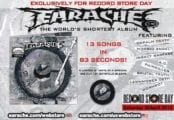[dropcap style=”font-size:100px; color:#992211;”]Z[/dropcap]immer in the Frame
When Walt Disney’s architects of the future designed Disneyland back in the 1950’s they waited to see where people actually walked before the layout of the paths was finalised. In this way the park assimilated the tactical trajectories of its visitors so that walking across the grass lost its subversive appeal.
It is easier and more efficient to keep to the walkways.
I imagine that my previous sentence was a silent mantra for Hans Zimmer as he entered the Hollywood arena back in the 1980s. I also imagine that there was a confident spring to his Teutonic footsteps as the times, the tides and the latest technological innovations were all firmly on his side. Where others saw a personal commitment towards creating an artistic complement for screen drama, he peered into the near future and visualised a glistening service industry finely tuned to the wants, rather than the needs, of his future employers.
In order to understand the changeover from a composer-determined approach into one based solely on test results and reliable manufacture, we must first back track to examine the old-school process of collaboration.
On a project such as Lawrence of Arabia the director David Lean would normally screen a rough cut of the film for the composer and then, a couple of months later when he had a final cut, invite him over to his house for a light lunch to be followed by a one-on-one performance of suggested musical ideas played on a grand piano in a luxurious drawing room.
Unfortunately Lean’s first and second choices (William Walton and Malcolm Arnold) dithered at the offer and then became ‘unavailable’. Deadlines were looming so Lean took a chance on a little known French composer, Maurice Jarre.
The director and composer hurriedly met to ‘spot’ the film in an edit suite. Spotting is still a vital strand of the whole music-to-picture process. It is where the director indicates, as precisely as possible, at what points music should enter and exit the audio landscape.
After an undoubtedly cordial professional encounter (and probably a slap-up meal in a posh restaurant) Jarre returned to his workplace to create memorable themes which would firmly establish time, place and a vivid inner life for the unemotional anti-hero. He would then collaborate with a sympathetic orchestral arranger in order to prepare musical charts for the recording sessions.
While Lean would wait
And probably suppress a rising panic.
A director of such quality, in this period, would be used to stretching his long delicate fingers over every aspect of the production with minimal studio interference; approving locations, costume, production design and probably even the precise length of Peter O’ Toole’s formidable nose hair.
But the music was always a wild card – a leap of faith. All you could do was select a composer based on his character and previous work, give him a jolly good brief and then wait for the result. In those days there were no work-in-progress demos arriving daily on a computer and consequently no opportunity to fiddle with the organic development of the score, or dare to suggest that the composer ‘appropriate’ a theme from a favourite Radiohead track.
The first time the director would have a chance to hear how the music actually sounded and judge how well it complimented the picture would be at the recording session.
It must have been an excruciating six week wait for a man as driven as Lean, someone who, as an ex-film editor, would be keenly aware that even a single ‘wrong’ music cue could easily subvert his precise intentions for the emotional impact of his movie. I suspect that he bore it with fortitude by taking a well-earned holiday in an exotic clime.
This seemingly tenuous process mostly produced outstanding results, as in the case of Lawrence of Arabia. The great composers like Jarre responded heroically to the high expectations of both director and studio. Certainly the director might tweak the thing with the help of a music editor’s magic scissors, lose a cue in the mix, or replace one with some ethnic source better suited to the scene, but the homogeneity of the score always remained intact.
Still
There was that long annoying wait between rough cut and final mix when the composer was walking alone on the grass, feeling his way towards his destination. If only there were some means of closing this worrying gap in the process and someone with the determination, technology and subservient presentation skills to be able to do it.
Smooth and efficient Walkways were required.
Enter the Hun.
In the next thrilling installment I will compare the process outlined above with the modern ‘factory’ style of collaboration between Hollywood talent bosses such as Mr. Nolan and Mr. Zimmer, explore the damaging impact of test screening on the work of modern composers, explain why many Arrangers were suddenly elevated to Composer status and, perhaps surprisingly, applaud the ‘needledrop’ kings: Kubrick and Tarantino.
TO BE CONTINUED

Having completed principal photography on phase one of the Sharks revival SWP is now preparing to edit the One Last Thrill feature documentary. Sharks themselves are ‘dropping a big one’ by releasing a double album Dark Beatles/White Temptations in April 2018.
In his spare time the author kayaks the muddy river Ouse and walks the South Downs which gently enfold his home town of Lewes.




















